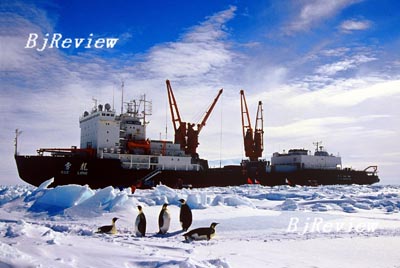
This is set to be an important year for China's South Pole scientific research, as the country has set out to update its two research stations in the Antarctic and is making preparations to build a third.
Renovations, which will cost more than 100 million yuan ($13 million), started on the Changcheng (Great Wall) Station early this August. The station was built in 1985 on King George Island. Renovation work is due to be completed by the end of the year, according to Qin Weijia, Deputy Director of the Polar Research Institute of China (PRIC).
Though the Changcheng Station underwent several expansions in 1986, 1992 and 1996, which brought its size to the current 4,200 square meters, facilities at the station have become outdated and some cement and steel structures have been eroded by underground water. "Some floors have cracked and crumbled, and become very dangerous," Qin said.
Renovation work will also begin on the Zhongshan Station next year, which was built in 1989 on the Larsemann Hills and covers an area of 2,700 square meters.
The renovated facilities will save energy and be more environment-friendly than the old ones, Qin said. They will include a 1,000-square-meter scientific research building and a waste and sewage treatment center to be constructed in the Changcheng Station.
"The size of the station will be enlarged by 1,980 square meters after the renovation," said Qin, adding that the expansion area will be even larger for the Zhongshan Station.
After the update, the Changcheng Station will be able to provide good service as a scientific research center for 10 to 15 years, according to Zhang Zhanhai, Director of the PRIC.
The renovation mission is just a small part of China's research blueprint for Antarctic. In 2006, the Chinese Government allocated a total of 570 million yuan for major Antarctic research projects, of which 32 million was given to the IPY Chinese Project (IPY stands for the International Polar Year, an international event during which scientists carry out large-scale joint scientific activities), 150 million to the development of the Shanghai-based Polar Research Institute, 180 million to the renovations of the two existing Antarctic research stations and 200 million to the update of a polar expedition ship Xuelong (Snow Dragon).
Third station
Polar research has become a hot topic in the international scientific community and the peculiar geographic positions and unique natural environments of the poles provide ideal locations to study evolution and global climate changes. Hence China is stepping up its efforts to build a third Antarctic research station.
The new research station will be built on Dome A, the highest icecap in the Antarctic, in 2009, "if nothing goes wrong," Cui Xiangqun, Deputy Director of the Chinese Center for Antarctic Astronomy, said at a recent astronomy conference in Nanjing, Jiangsu Province.
The new station, named Duxia, will be the world's first station on the highest point in the Antarctic. Chinese scientists are already receiving acclimatization training in Tibet to prepare them to land on Dome A, where temperatures are believed to reach 90 degrees centigrade below zero. It has long been considered an "unapproachable area."
Duxia, which translates as "spending summer," will complement the research efforts of the Zhongshan and Changcheng stations, which are near the coast.
"As the first inland station, Duxia is important for Chinese scientific research in the Antarctic," Wu Jun, an official with the Chinese Arctic and Antarctic Administra-tion, said.
In January 2005, a Chinese national Antarctic research expedition team traveled 1,228 km from Zhongshan Station to Dome A and located the highest point of the ice sheet.
The polar expedition ship Xuelong will take an expedition team to Dome A this October when the ship's renovation work comes to an end. Being China's 24th Antarctic expedition since 1984, this year's expedition will bear the task of making preparations for the construction of the country's third South Pole research station Duxia, as well as conducting geological exploration, according to Zhang from the PRIC. | 